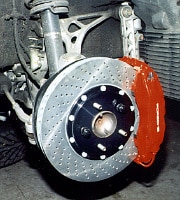
Brake Shop Guide: Understanding Different Types of Brakes” delves into the intricate world of braking systems, offering invaluable insights to both novices and seasoned motorists. Exploring the diverse array of brake types, the guide elucidates their functionalities, advantages, and ideal usage scenarios. From traditional drum brakes renowned for their simplicity and durability to the more modern disc brakes celebrated for their superior performance and heat dissipation capabilities, each type is meticulously dissected. Moreover, the guide navigates through the nuances of specialized braking systems like regenerative brakes, which harness kinetic energy to recharge batteries in hybrid and electric vehicles, showcasing the cutting-edge advancements driving automotive innovation. By elucidating the mechanics behind each brake type and their respective pros and cons, this comprehensive guide empowers readers to make informed decisions when it comes to maintaining, upgrading, or selecting brakes for their vehicles, ultimately ensuring optimal safety and performance on the road.
Introduction to Brakes: A Brief Overview
Brakes are a fundamental component of any vehicle, serving as a critical safety feature and enabling control over speed and motion. Essentially, they work by converting kinetic energy into heat energy through friction, thus slowing down or stopping the vehicle. While the basic principle remains the same across various types of brakes, advancements in technology have led to the development of different braking systems tailored to specific needs and preferences. Understanding the basics of how brakes function is essential for all drivers, as it empowers them to make informed decisions regarding maintenance, upgrades, and driving techniques to ensure optimal safety on the road.
Disc Brakes vs. Drum Brakes: Unraveling the Key Differences
Disc brakes and drum brakes are the two primary types of braking systems used in vehicles, each with its own set of advantages and disadvantages. Disc brakes feature a rotor and caliper assembly, where the caliper clamps down on the rotor to create friction and slow the vehicle. On the other hand, drum brakes utilize brake shoes that press against the interior surface of a drum to achieve the same result. While disc brakes offer better heat dissipation and are more efficient at dissipating water, drum brakes are often more cost-effective and simpler in design. Understanding the distinctions between these two systems is crucial for drivers looking to make informed decisions about their vehicle’s braking capabilities.
Exploring Anti-lock Braking Systems (ABS) and Their Importance
Anti-lock Braking Systems (ABS) represent a significant advancement in automotive safety technology. ABS works by preventing the wheels from locking up during braking, thereby allowing the driver to maintain steering control and avoid skidding. This is achieved through a series of sensors that monitor wheel speed and a control unit that modulates brake pressure to each wheel accordingly. By pulsating the brakes rapidly, ABS helps vehicles to stop more quickly and effectively on slippery or uneven surfaces. The importance of ABS cannot be overstated, as it significantly reduces the risk of accidents, especially during emergency braking situations. Understanding how ABS functions and its benefits empowers drivers to utilize this technology effectively and enhances overall road safety.
The Role of Hydraulic Brakes in Vehicle Safety and Performance
Hydraulic brakes are a cornerstone of modern vehicle braking systems, offering a reliable and efficient method for slowing down or stopping vehicles. This system utilizes hydraulic fluid to transfer force from the brake pedal to the brake pads or shoes, exerting pressure on the braking components and generating friction to decelerate the vehicle. The hydraulic nature of this system ensures a consistent and responsive braking experience, with minimal delay between pedal application and brake response. Furthermore, hydraulic brakes can provide significant braking force with relatively little effort from the driver, enhancing both safety and driving comfort. Understanding the role of hydraulic brakes in vehicle safety and performance underscores their importance in maintaining optimal braking efficiency and control on the road.
Understanding Regenerative Braking: Eco-Friendly Innovation in Motion
Regenerative braking represents a groundbreaking innovation in automotive technology that not only enhances braking efficiency but also contributes to environmental sustainability. This system works by converting kinetic energy into electrical energy during braking, which is then stored in a battery or capacitor for later use. Unlike traditional braking systems, which dissipate energy as heat, regenerative braking recaptures some of that energy, effectively recycling it back into the vehicle’s power system. By reducing reliance on friction-based braking, regenerative braking not only improves fuel efficiency but also extends the range of electric and hybrid vehicles. Understanding how regenerative braking works and its benefits can inspire drivers to adopt more eco-friendly driving practices and contribute to the reduction of carbon emissions in the transportation sector.
Brake Pad Materials: Choosing the Right Option for Your Vehicle
Brake pads play a crucial role in your vehicle’s braking system, providing the necessary friction to slow down or stop your vehicle safely. However, not all brake pads are created equal, as they come in various materials, each with its own set of characteristics and performance attributes. Understanding the different brake pad materials can help you make an informed decision when it comes to selecting the right option for your vehicle.
- Ceramic Brake Pads: Known for their quiet operation and low dust production. Offer excellent performance and durability under normal driving conditions. Ideal for daily commuting and city driving.
- Semi-Metallic Brake Pads: Made from a mixture of metals and organic materials. Provide enhanced stopping power and heat dissipation. Suitable for heavy-duty applications and high-performance driving.
- Organic Brake Pads: Composed of non-metallic materials such as rubber, Kevlar, or glass. Offer smooth and quiet braking performance. Often preferred for their eco-friendly composition and affordable price.
Choosing the right brake pad material is essential for maintaining optimal braking performance and safety on the road. Consider factors such as your driving habits, vehicle type, and budget when selecting brake pads for your vehicle. By understanding the characteristics of different brake pad materials, you can make an informed decision that meets your needs and ensures reliable braking performance.
Maintenance Matters: Tips for Extending the Lifespan of Your Braking System
Regular maintenance is key to ensuring the longevity and reliability of your vehicle’s braking system. By implementing a few simple maintenance practices, you can extend the lifespan of your brakes and avoid costly repairs or replacements down the road. Here are some tips for maintaining your braking system and maximizing its efficiency.
- Check Brake Fluid Regularly: Ensure that the brake fluid level is within the recommended range. Top up or replace brake fluid as needed to maintain optimal brake performance.
- Inspect Brake Pads and Rotors: Check brake pads for wear and replace them if they are worn down beyond a certain thickness. Inspect brake rotors for signs of damage or warping and resurface or replace them if necessary.
- Lubricate Brake Components: Apply brake lubricant to caliper slides, pins, and other moving parts to prevent corrosion and ensure smooth operation. Avoid getting lubricant on brake pads or rotors, as this can affect braking performance.
By incorporating these maintenance tips into your routine vehicle care, you can prolong the lifespan of your braking system and enjoy reliable stopping power for miles to come. Remember to consult your vehicle’s owner’s manual for specific maintenance intervals and procedures, and don’t hesitate to seek professional assistance if you’re unsure about any aspect of brake system maintenance. With proper care and attention, you can keep your brakes in top condition and drive with confidence on the road.
Conclusion
Last Chance Auto Repair For Cars Trucks provides a comprehensive guide to understanding the different types of brakes, catering to the diverse needs of vehicle owners. With a commitment to ensuring safety and efficiency on the road, the brake shop offers invaluable insights into brake systems, empowering customers to make informed decisions about their vehicle maintenance. Whether it’s disc brakes, drum brakes, or specialized systems like regenerative brakes, Last Chance Auto Repair equips clients with the knowledge necessary to navigate the complexities of brake technology. By prioritizing education and transparency, the shop fosters trust and loyalty among its clientele, establishing itself as a reliable authority in automotive care. With Last Chance Auto Repair, customers can rest assured that their braking needs will be met with precision and expertise, ensuring optimal performance and peace of mind every time they hit the road.


